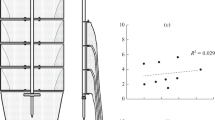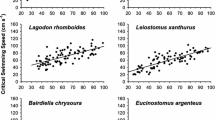Abstract
Both the vertical and horizontal distributions ofEurydice pulchra (Leach) within the water column of the surf zone were recorded throughout complete tidal cycles on a sandy beach in North Wales during the summer of 1989. Upon emerging from the sand, the isopods tended to swim up in the water column, where transport onshore would be facilitated by the wave-induced, onshore currents which laboratory wave-tank experiments have confirmed to occur near the water surface. This combination of active and passive transport to the water's edge results in high numbers of individuals in the narrow swash zone. At and just after the time of high tide, individuals swim to the water/sediment interface where, as again confirmed by wave-tank experiments, the predominant water movement is offshore. Continued swimming near the bottom during the ebb tide before reburrowing in the sand ensures transport downshore and avoidance of stranding above the characteristic level of zonation on the shore. Vertical migrations ofE. pulchra in the water column permit differential exploitation of up and downshore currents to achieve horizontal migration.
Similar content being viewed by others
Literature cited
Al-Adhub, A. H. Y., Naylor, E. (1975). Emergence rhythms and tidal migrations in the brown shrimpCrangon crangon (L.). J. mar. biol. Ass. U.K. 55: 801–810
Alheit, J., Naylor, E. (1976). Behavioural basis of intertidal zonation inEurydice pulchra (Leach). J. exp. mar. Biol. Ecol. 23: 135–144
Cronin, T. W., Forward, R. B., Jr. (1982). Tidally timed behaviour: effects on larval distributions in estuaries. In: Kennedy, V. S. (ed.) Estuarine comparisons. Academic Press, New York, p. 505–520 (ISBN 0124040705)
Dyhr-Nielson, M., Sorensen, T. (1970). Some sand transport phenomena on coasts with bars. In: Proceedings of the Twelfth Coastal Engineering Conference, Washington D.C. Vol. II. American Society of Civil Engineers, New York, p. 855–866
Enright, J. T. (1963). The tidal rhythm of activity of a sand-beach amphipod. Z. vergl. Physiol. 46: 276–313
Enright, J. T. (1972). A virtuoso isopod: circa-lunar rhythms and their tidal fine structure. J. comp. Physiol. 77: 141–162
Forward, R. B., Jr. (1980). Phototaxis of a sand-beach amphipod: physiology and tidal rhythms. J. comp. Physiol. 135: 243–250
Fincham, A. A. (1972). Rhythmic swimming and rheotropism in the amphipodMarinogammarus marinus (Leach). J. exp. mar. Biol. Ecol. 8: 19–26
Fish, J. D., Fish, S. (1972). The swimming rhythm ofEurydice pulchra (Leach) and a possible explanation of intertidal migration. J. exp. mar. Biol. Ecol. 8: 195–200
Hastings, M. H. (1980). Aspects of the ecology of sandy-shore crustacea. Ph. D. thesis. University of Liverpool, Port Erin
Hastings, M. H., Naylor, E. (1980). Ontogeny of an endogenous rhythm inEurydice pulchra. J. exp. mar. Biol. Ecol. 46: 137–145
Holdich, D. M. (1981). Opportunistic feeding behaviour in a predatory isopod. Crustaceana 41: 101–103
Hough, A. R., Naylor, E. (1991). The behavioural basis of crustacean distribution in a tidally mixed estuary. Mem. Qd Mus. (in press)
Jones, D. A., Hobbins, C. St. C. (1985). The role of biological rhythms in some sand beach cirolanid isopoda. J. exp. mar. Biol. Ecol. 93: 47–59
Jones, D. A., Naylor, E. (1970). The swimming rhythm of the sand beach isopodEurydice pulchra. J. exp. mar. Biol. Ecol. 4: 188–199
Komar, P. D. (1976). Beach processes and sedimentation. Prentice-Hall Inc., Englewood Cliffs, New Jersey (ISBN 0130725951)
McLachlan, A., Wooldridge, T., Van der Horst, G. (1979). Tidal movements of the macrofauna on an exposed sandy beach in South Africa. J. Zool., Lond. 188: 433–442
Naylor, E. (1985). Tidally rhythmic behaviour of marine animals. Symp. Soc. exp. Biol. 39: 63–93
Naylor, E. (1988). Clock-controlled behaviour in intertidal animals. In: Chelazzi, G., Vannini, M. (eds.) Behavioural adaptations to intertidal life (NATO ASI Series). Plenum Press, New York & London (ISBN 0306429306)
Author information
Authors and Affiliations
Additional information
Communicated by J. Mauchline, Oban
Rights and permissions
About this article
Cite this article
Warman, C.G., O'Hare, T.J. & Naylor, E. Vertical swimming in wave-induced currents as a control mechanism of intertidal migration by a sand-beach isopod. Mar. Biol. 111, 49–54 (1991). https://doi.org/10.1007/BF01986345
Accepted:
Issue Date:
DOI: https://doi.org/10.1007/BF01986345




